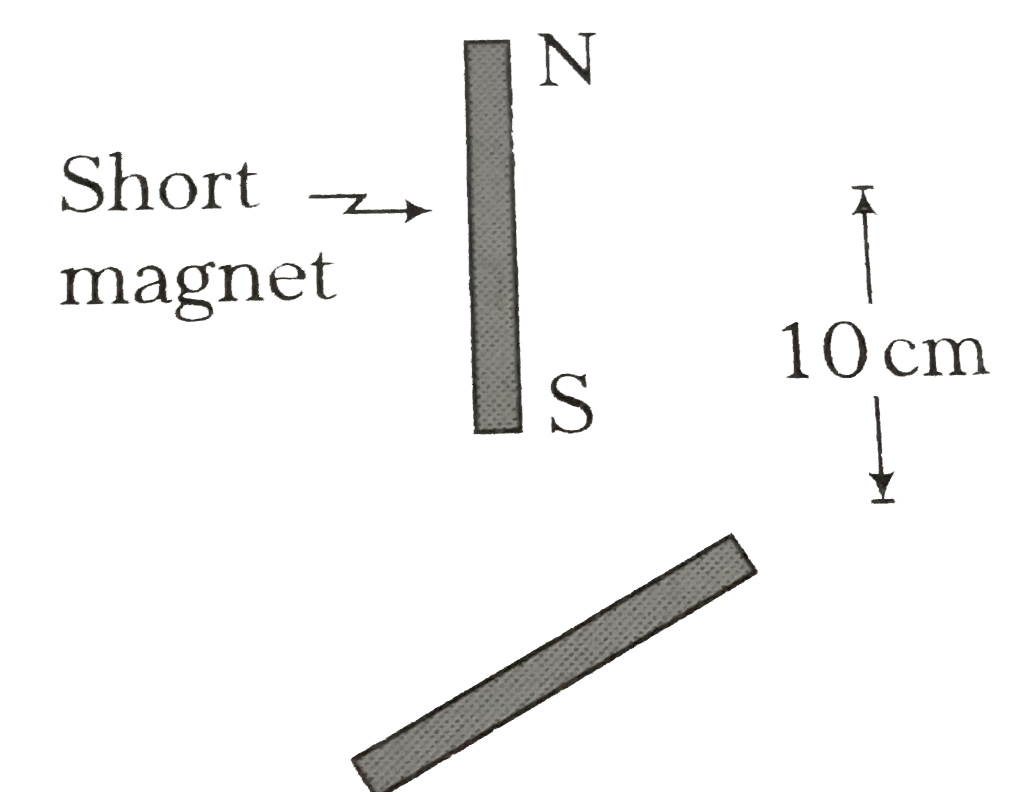The magnet of vibration magnetometer is heated so as to reduce its magnetic moment by 36%. By doing this the periodic time of the magnetometer will
Increases by 67%
Increases by 25%
Increases by 12%
Is not changed
The correct Answer is:B
To solve the problem, we need to analyze how the reduction in the magnetic moment affects the periodic time of the vibration magnetometer.
1. Understand the relationship between time period and magnetic moment:
The time period T of a vibration magnetometer is given by the formula:
T=2π√Im⋅B
where:
- I is the moment of inertia,
- m is the magnetic moment,
- B is the magnetic field.
From this equation, we can see that the time period T is inversely proportional to the square root of the magnetic moment m.
2. Define initial and final magnetic moments:
Let the initial magnetic moment be m1 and the final magnetic moment after heating be m2. According to the problem, the magnetic moment is reduced by 36%. Therefore:
m1=100(assuming initial magnetic moment is 100 units)
m2=m1−0.36⋅m1=100−36=64
3. Calculate the ratio of the time periods:
The ratio of the time periods T1 (initial) and T2 (final) can be expressed as:
T1T2=√m2m1=√64100=√0.64=810=0.8
4. Express T2 in terms of T1:
Rearranging the ratio gives:
T2=108T1=1.25T1
5. Determine the percentage increase in the time period:
The increase in the time period can be calculated as:
Percentage Increase=(T2−T1T1)×100%=(1.25T1−T1T1)×100%=(0.25)×100%=25%
Conclusion:
The periodic time of the magnetometer will increase by 25%.
---
The time period T of a vibration magnetometer is given by the formula:
T=2π√Im⋅B
where:
- I is the moment of inertia,
- m is the magnetic moment,
- B is the magnetic field.
Let the initial magnetic moment be m1 and the final magnetic moment after heating be m2. According to the problem, the magnetic moment is reduced by 36%. Therefore:
m1=100(assuming initial magnetic moment is 100 units)
m2=m1−0.36⋅m1=100−36=64
The ratio of the time periods T1 (initial) and T2 (final) can be expressed as:
T1T2=√m2m1=√64100=√0.64=810=0.8
Rearranging the ratio gives:
T2=108T1=1.25T1
The increase in the time period can be calculated as:
Percentage Increase=(T2−T1T1)×100%=(1.25T1−T1T1)×100%=(0.25)×100%=25%
The periodic time of the magnetometer will increase by 25%.
Topper's Solved these Questions
- MAGNETISM AND MATTER BOOK - AAKASH INSTITUTE ENGLISHCHAPTER - MAGNETISM AND MATTER EXERCISE - Assignment Section- C Linked Comprehension Type Questions
3 Videos
- MAGNETISM AND MATTER BOOK - AAKASH INSTITUTE ENGLISHCHAPTER - MAGNETISM AND MATTER EXERCISE - Assignment Section D (Assertion- Reason Type Questions)
8 Videos
- MAGNETISM AND MATTER BOOK - AAKASH INSTITUTE ENGLISHCHAPTER - MAGNETISM AND MATTER EXERCISE - Assignment Section - A Objective Type Questions (One option is correct)
58 Videos
- LAWS OF MOTIONBOOK - AAKASH INSTITUTE ENGLISHCHAPTER - LAWS OF MOTIONEXERCISE - Assignment (SECTION-D) (Assertion-Reason Type Questions)
15 Videos
- MECHANICAL PROPERTIES OF FLUIDSBOOK - AAKASH INSTITUTE ENGLISHCHAPTER - MECHANICAL PROPERTIES OF FLUIDSEXERCISE - SECTION - J
9 Videos
Similar Questions
The magnet of a vibration magnetometer is heated so as to reduce its magnetic moment by 19%. By doing this the period time of the magnetometer will
View SolutionThe perio of oscillation of a magnet in vibration magnetometer is 2 sec. The period of oscillation of a magnet whosr magnetic moment is four times that of the first magnet is
View SolutionFor a vibration magnetometer, the time period of suspended bar magnet can be reduced by -
View SolutionThe time period of the magnetic in an oscillation pmagnetometer in the earth magnetic field is 2s. A short bar magnet is placed to the north of the magnetometer, at a separation 10cm from the oscillation magnet, with its north pole pointing towards north. The time period beceomes half. Calculate the magnetic moment of this short magnet.

View SolutionThe time period of a vibration magnetometer is T0. Its magnet is replaced by another magnet whose moment of inertia is 3 times and magnetic moment is 1/3 of the initial magnet. The time period now will
View SolutionA vibration magnetometer is placed at the south pole, then the time period will be
View SolutionWith a standard rectangular bar magnet the time period of a vibration magnetometer is 4 s. The bar magnet is cut parallel to its length into four equal pieces. The time period of vibration magnetometer when one piece is used (in second) (bar magnet breadth is small) is
View SolutionA bar magnet of mass 100 g, length 7.0 cm, width 1.0 cm and height 0.50 cm takes π2 seconds to complete an oscillation in an oscillation magnetometer placed in a horizontal magnetic field of 25μT. (a) Find the magnetic moment of the magnet. (b) If the magnet is put in the magnetometer with its 0.50cm edge horizontal, what would be the time period?
View SolutionThe period of oscillation of a magnet of a vibraion magnetometer is 2.45 s at ione place and 4.9 s at the other, the ratio of the horzontal component of earth magnetic field at the two places is
View SolutionAn iron rod of length L and magnetic moment M is bent in the form of a semicircle. Now its magnetic moment will be
View Solution
